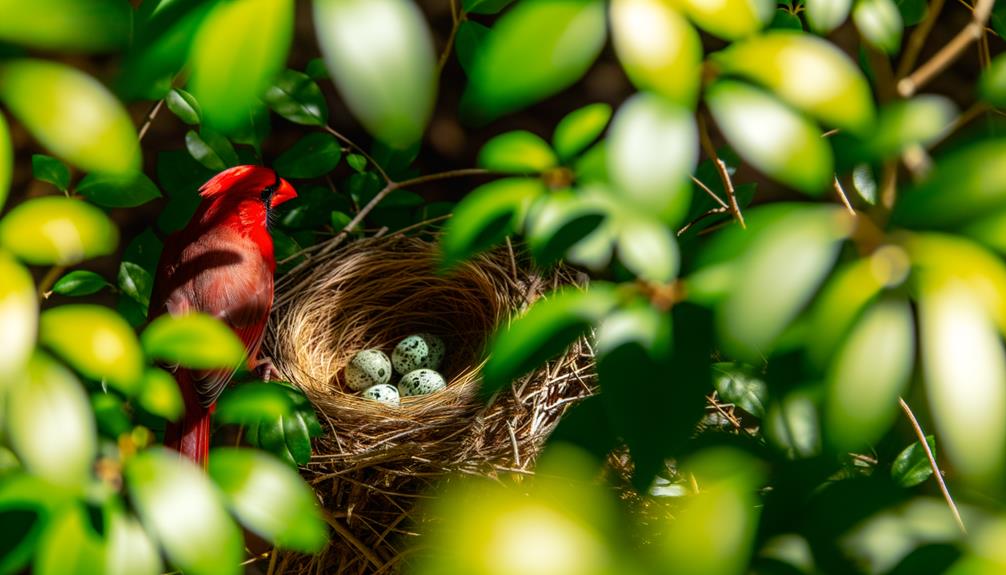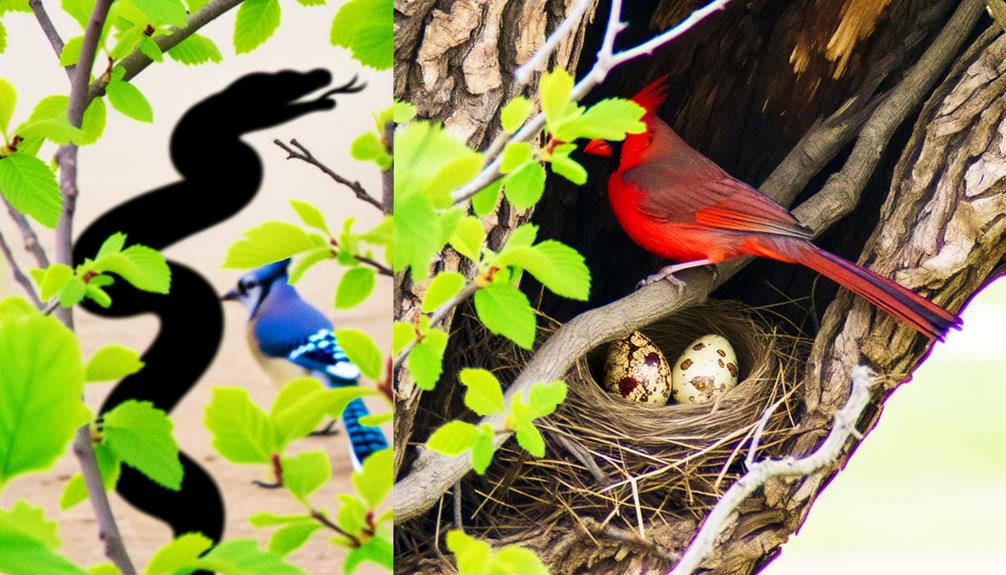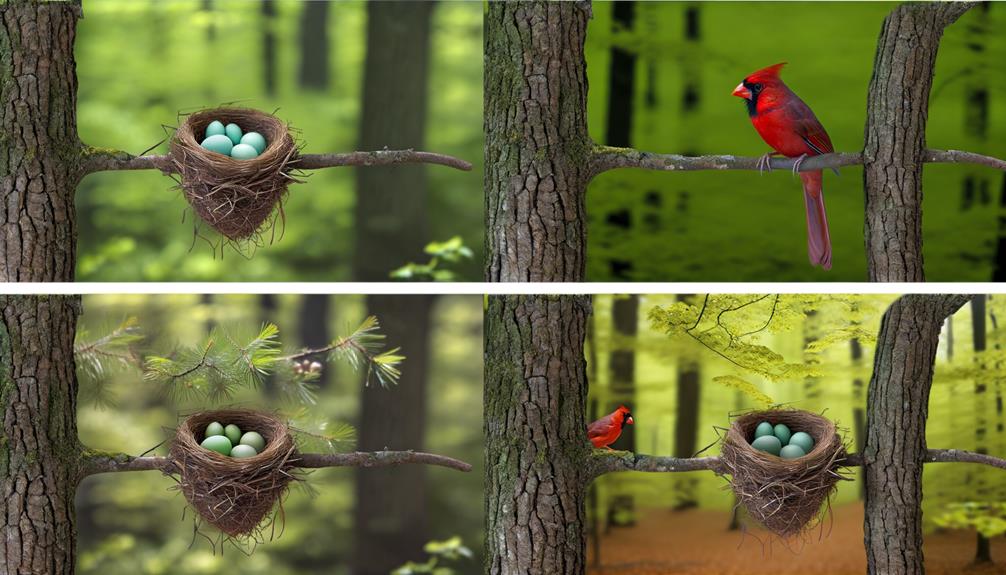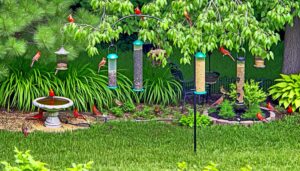Do Cardinals Steal Other Birds’ Eggs?
Cardinals don't steal other birds' eggs. Unlike American Crows or Blue Jays, which are known for such behavior, cardinals focus on constructing well-hidden nests using twigs, bark strips, and grasses.
They show strong parental investment, both parents engaging in incubation and feeding. Common nest predators impacting cardinals include snakes, raccoons, and certain birds, which notably affect their reproductive success.
Ensuring adequate nest concealment and location optimization aids their survival. To better understand bird species interactions and behaviors, exploring detailed studies and observations can be enlightening.

Key Takeaways
- Cardinals do not typically steal other birds' eggs.
- Cardinals mainly focus on foraging for seeds, fruits, and insects.
- Territorial aggression is aimed at protecting their territory, not acquiring eggs.
- Cardinals exhibit strong parental investment in their own offspring.
- Cardinals' nesting habits prioritize secrecy and protection, not predation.
Cardinal Behavior Overview

Cardinals exhibit a diverse range of behaviors, including territorial aggression, complex vocalizations, and diligent nesting practices. You'll notice their territorial aggression peaks during breeding seasons, ensuring best resources and safety for their offspring.
Males display bright plumage and engage in combative displays to ward off intruders. Their complex vocalizations serve multiple functions, from attracting mates to signaling alarm. Studies indicate over 24 unique song types in a cardinal's repertoire.
Cardinals are diurnal, foraging primarily during daylight, maximizing effectiveness in food gathering. They don't engage in brood parasitism; rather, they exhibit strong parental investment. Understanding these behaviors highlights their adaptability and intricate social structures, offering you deeper insights into their natural freedom and survival strategies.
Nesting Habits of Cardinals
You should examine the preferred nesting locations of cardinals, which typically include dense shrubs and low tree branches.
Cardinals construct their nests using materials such as twigs, leaves, and grass.
Both male and female cardinals share parental responsibilities, with the female primarily incubating the eggs while the male provides food.
Preferred Nesting Locations
While seeking top nesting sites, Northern Cardinals mainly choose dense shrubbery or thick tangles of vines to guarantee protection and concealment. These locations provide prime cover against predators and environmental elements.
You'll often observe cardinals nesting in areas with:
- Thick foliage: Shrubs and low trees offer a dense canopy, enhancing secrecy.
- Dense vines: Tangles of vines create a natural barrier, deterring intruders.
- Partially-open forests: Edges of forests provide ample cover while allowing easy access to food sources.
This preference for concealed nesting sites ensures superior survival rates for their offspring. By selecting these specific locations, Northern Cardinals effectively minimize threats and optimize their reproductive success. Understanding these habits can help you appreciate their nesting strategies and the importance of habitat conservation.
Nest Construction Materials
In constructing their nests, Northern Cardinals primarily use twigs, bark strips, grasses, and leaves, ensuring structural integrity and comfort for their eggs.
You'll find that the inner layer often comprises fine grasses and soft materials, providing a cushioned environment. Cardinals exhibit meticulous selection in materials, optimizing thermal insulation and protection against predators.
Studies indicate that their nests average 5-10 cm in height and 10-20 cm in diameter, balancing size and security. They typically build nests within 1-3 meters above ground, integrating them into dense shrubbery.
This strategic placement minimizes exposure to the elements and potential threats, ensuring a high survival rate for hatchlings. Understanding these nesting habits reveals the cardinals' adaptive strategies in varying environments.
Parental Responsibilities
Once the nest is constructed, Northern Cardinals demonstrate remarkable parental responsibilities, with both males and females actively participating in incubating eggs and feeding hatchlings.
You'll notice that both parents take turns keeping the eggs warm, ensuring ideal development. Their cooperation extends to feeding the chicks, where they bring a variety of insects and seeds to meet the nutritional needs of their young.
Consider these key points:
- Incubation Sharing: Males and females share incubation duties, typically lasting 11-13 days.
- Feeding Duties: Both parents feed hatchlings, providing high-protein diets for rapid growth.
- Nest Defense: Northern Cardinals actively defend their nests from potential predators, ensuring the safety of their offspring.
This cooperative behavior underscores their commitment to offspring survival.
Common Nest Predators

You'll find that common nest predators include snakes and various reptiles, which are responsible for significant egg predation.
Additionally, mammals such as raccoons and squirrels often target bird nests for their eggs.
Other bird species, including jays and crows, also pose a substantial threat to nests.
Snakes and Reptiles
Snakes and reptiles, such as rat snakes and lizards, frequently prey on bird nests, greatly impacting avian reproductive success. You might be surprised at how these predators can influence bird populations. Here's why they're so effective:
- Climbing Abilities: Many snakes and lizards can ascend trees and shrubs, making nests accessible.
- Stealth: Their quiet, sneaky movements often go unnoticed by parent birds.
- Dietary Flexibility: Snakes and lizards consume a variety of prey, including bird eggs and chicks, boosting their survival.
Studies show that rat snakes can consume entire clutches of eggs, significantly reducing reproductive rates.
Monitoring and mitigating these predators is essential for conserving bird populations. Understanding these threats empowers you to contribute to effective avian conservation strategies.
Mammals as Predators
Many mammals, such as raccoons, squirrels, and cats, are common nest predators that have a noticeable impact on bird populations by preying on eggs and chicks. These predators exhibit various hunting behaviors that significantly impact avian reproductive success. Understanding their influence helps in developing effective conservation strategies.
| Mammal | Common Prey | Impact on Bird Populations |
|---|---|---|
| Raccoon | Eggs, Chicks | High |
| Squirrel | Eggs | Moderate |
| Cat | Eggs, Chicks | Severe |
| Fox | Eggs, Chicks | Moderate |
| Skunk | Eggs | Low |
You can observe that raccoons and cats exert the most severe pressure on bird nests. By addressing these mammalian threats, you can contribute to improving bird conservation efforts and fostering biodiversity.
Other Bird Species
Beyond mammals, avian species also play a notable role as predators of bird nests, impacting reproductive success by preying on eggs and chicks. You should be aware of several common avian nest predators that can profoundly affect bird populations. These species utilize their unique adaptations to locate and consume eggs or young birds, leading to a considerable impact on nesting success rates.
Here are three common avian nest predators:
- American Crows (Corvus brachyrhynchos): Known for their intelligence, they can locate and raid nests with remarkable efficiency.
- Blue Jays (Cyanocitta cristata): These birds are notorious for their aggressive behavior and are frequent nest raiders.
- European Starlings (Sturnus vulgaris): Invasive and highly adaptable, they often outcompete native species for nesting sites.
Evidence of Egg Stealing
Observational studies and documented reports provide compelling evidence that cardinals don't engage in the behavior of stealing other birds' eggs. Researchers have meticulously monitored cardinal nests and surrounding areas, finding no instances of egg theft.
Data collected from numerous field studies indicate that cardinals primarily focus on their own reproductive success. They invest significant time and resources in nesting, incubating, and feeding their young.
Additionally, video surveillance of cardinal habitats confirms their diet consists mainly of seeds, fruits, and insects, not avian eggs. Such empirical findings underscore the cardinals' non-predatory nature towards other birds' offspring, freeing you from concerns about egg-stealing behavior when observing these vibrant songbirds in their natural environment.
Misconceptions About Cardinals

A common misconception about cardinals is that they engage in aggressive behaviors like stealing other birds' eggs. However, scientific data doesn't support this belief. Cardinals are generally passive, focusing on foraging and nesting within their territories.
Here's what you need to know:
- Diet: Cardinals primarily eat seeds, fruits, and insects, not eggs. Studies show a negligible percentage of eggs in their diet.
- Behavior: Observational data indicate that cardinals rarely display aggression towards other birds, especially concerning nests.
- Nesting: Cardinals build their nests in dense shrubs, providing little opportunity to interact with or steal from other species.
Understanding these points can help you appreciate cardinals for their true nature. Misconceptions shouldn't cloud your view of these fascinating birds.
Comparing Cardinals and Other Birds
When comparing cardinals to other birds, you'll find that their dietary habits, nesting behaviors, and social interactions set them apart. Cardinals primarily consume seeds and fruits, differing from insectivorous species. Nesting behaviors exhibit distinct patterns; cardinals construct open cup nests in dense shrubs, contrasting with cavity nesters. Social interactions reveal cardinals' monogamous tendencies, unlike the polygamous practices observed in some avian species.
| Characteristic | Cardinals | Other Birds |
|---|---|---|
| Diet | Seeds, fruits | Insects, small mammals, nectar |
| Nest Type | Open cup | Cavity, ground, platform |
| Social Interaction | Monogamous pairs | Polygamous, solitary |
| Nesting Location | Dense shrubs | Trees, burrows, open fields |
These distinctions underscore the unique ecological niche cardinals occupy, contributing to their identification in avian studies.
Protective Measures by Birds

Birds frequently employ a variety of protective measures to safeguard their eggs and nestlings from predators. You'll find these strategies fascinating and essential for avian survival.
Here are three key tactics:
- Camouflage: Birds often choose nesting sites that blend seamlessly with their surroundings, making it difficult for predators to spot the nests.
- Aggressive Defense: Some species, like the Northern Cardinal, exhibit aggressive behaviors such as dive-bombing intruders or vocal alarm calls to deter potential threats.
- Nest Concealment: Birds may build their nests in hard-to-reach locations, such as dense foliage or high branches, to reduce the likelihood of discovery.
These strategies, backed by evolutionary evidence, illustrate the complex methods birds use to protect their vulnerable offspring.
Impact on Bird Populations
Understanding these protective measures is essential as they directly influence bird population dynamics and overall avian biodiversity. When birds like cardinals engage in behaviors such as egg theft, they can greatly impact the reproductive success of other species. Data indicates that reduced hatching rates in victimized nests lead to decreased population growth.
You might notice shifts in species distribution and abundance, altering the ecosystem's balance. Studies reveal that avian diversity decreases when certain birds dominate through such competitive behaviors. Consequently, the intricate web of interspecies relationships undergoes strain, affecting not only the birds but also the broader ecological community.
Monitoring these dynamics is vital for maintaining ecological equilibrium and ensuring the freedom of various bird species to thrive.
Encouraging Ethical Bird Watching

Promoting ethical bird watching requires adherence to guidelines that minimize human impact on avian habitats and behaviors. To guarantee your bird watching practices are sustainable, follow these three key principles:
- Maintain Distance: Always observe birds from a distance using binoculars or a telephoto lens to avoid disturbing their natural activities.
- Stay Quiet: Minimize noise to prevent startling birds, which can lead to stress and disruption of their feeding or nesting routines.
- Respect Habitats: Avoid trampling vegetation or disturbing nesting areas, as this can lead to habitat degradation and negatively impact bird populations.
Conclusion
So, you've reached the end and still think cardinals are the egg-stealing villains of the avian world? Think again. While they're busy singing their hearts out and nurturing their own nests, it's the jays and crows you should be side-eyeing.
Contrary to popular belief, cardinals are more concerned with raising their young than pilfering eggs. Next time you're bird-watching, keep your binoculars trained on the real culprits, and give the cardinals a break—they've got enough on their plate.






